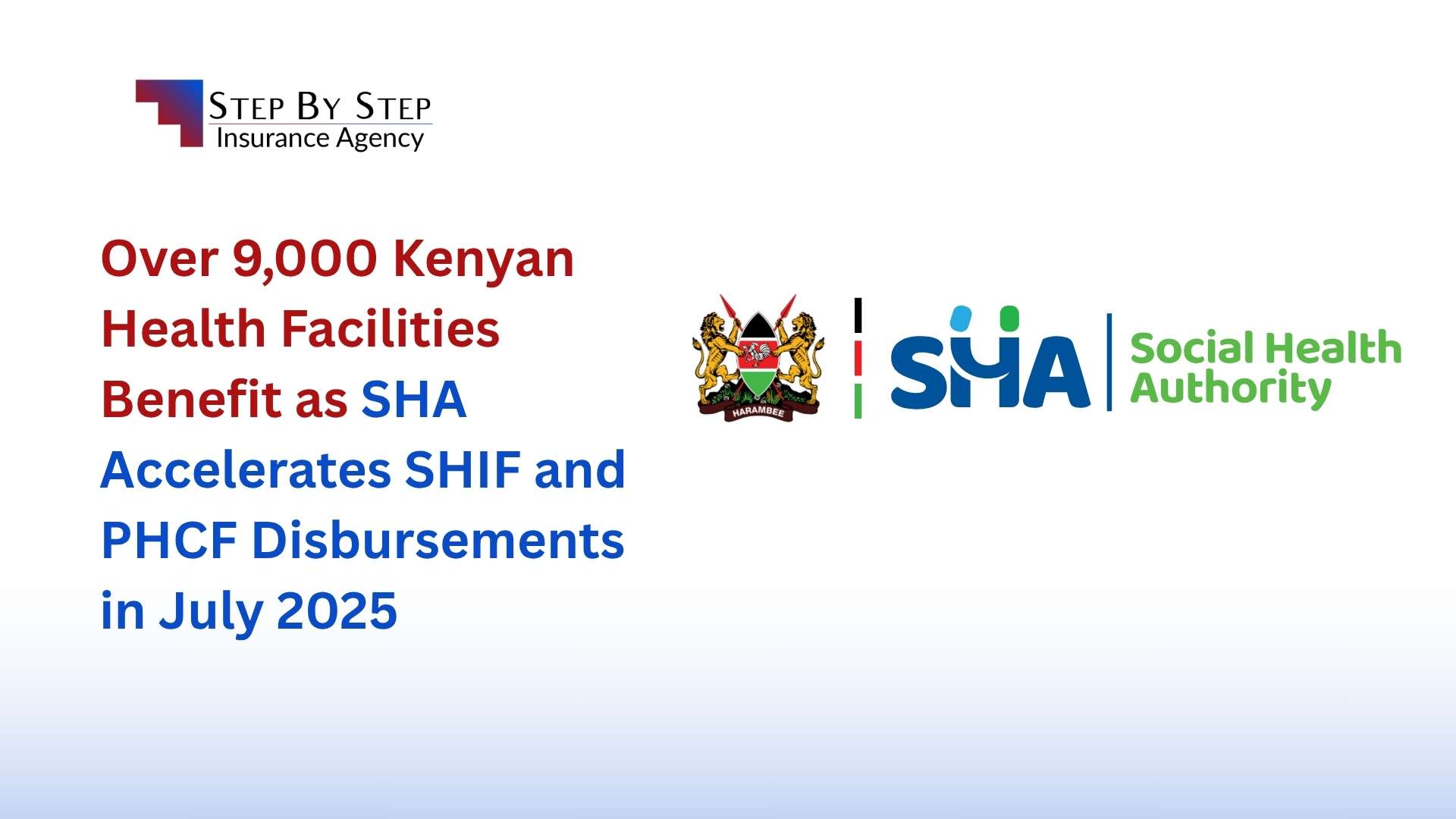Over 9,000 Kenyan Health Facilities Benefit as SHA Accelerates SHIF and PHCF Disbursements in July 2025
The healthcare sector in Kenya has long faced significant challenges, from limited access and high out-of-pocket costs to systemic funding delays. Over the past few years, amid efforts to reform and expand health coverage, financial bottlenecks have worsened, deeply affecting service providers and patients alike.
Key Takeaways
- SHA has initiated phased disbursements to nearly 9,000 healthcare facilities to address payment delays
- Only 20% of facilities received full reimbursements earlier in 2025, leaving 80% at risk
- The financial crisis has led to operational disruptions, staff resignations, and facility closures
- Timely disbursements are crucial for maintaining service quality and achieving Universal Health Coverage
- Sustained reforms are needed to ensure long-term stability of Kenya’s healthcare financing
Table of Contents
Join Our Insurance Community
Connect with industry professionals and stay updated on the latest insurance trends, news, and opportunities in Kenya’s evolving healthcare landscape.
Join WhatsApp GroupI. Background: The Social Health Authority and Its Role in Financing Healthcare
The Social Health Authority (SHA) is charged with administering and managing key health financing mechanisms in Kenya, notably the Social Health Insurance Fund (SHIF) and the Primary Health Care Fund (PHCF). These funds are crucial because they provide the financial flows that keep thousands of healthcare facilities operational, particularly those offering essential primary healthcare services.
Both SHIF and PHCF aim to cover healthcare costs for Kenyans and move the country closer to achieving Universal Health Coverage (UHC), which is a cornerstone of the government’s “Taifa Care” initiative. However, the implementation of these schemes has not been seamless. Stakeholders have faced numerous hurdles, including transitioning from the defunct National Health Insurance Fund (NHIF), delayed reimbursements, and financial strain on healthcare providers.
II. The Phased Disbursement: What Has Happened?
A. The Two-Phase Payment Rollout
On July 14 and July 21, 2025, the Social Health Authority began disbursing verified claims from SHIF and PHCF to healthcare providers in two phases. This move was designed to begin addressing long-standing payment delays that have had devastating effects on health facilities across the country.
Nearly 9,000 facilities, stretching across public, private, and faith-based providers, are beneficiaries of these disbursements. The phased approach was planned to ensure accurate verification of claims, maximize transparency, and gradually ease the cash flow bottleneck crippling Kenya’s healthcare services.
B. The Drivers Behind the Disbursement
This announcement follows months of mounting pressure from providers who struggled with inconsistent and delayed payments. Reports indicated that only about 20% of facilities received full reimbursements earlier in 2025—a startling figure that left 80% at risk. Facilities reliant on these funds faced mounting debts, operational disruptions, and in some distressing cases, legal battles and closures.
This financial crisis has fueled a dialogue about the sustainability of health financing mechanisms in Kenya and highlighted the urgent need to streamline claims verification, funding allocations, and accountability.
III. The Ripple Effects of Payment Delays on Healthcare Providers
A. Operational and Financial Strain
Delayed payments from government funds to healthcare facilities create a cascade of operational challenges. Facilities struggle to pay staff salaries—prompting mass resignations, salary delays, and diminished morale. Many hospitals and clinics also grapple with procuring essential drugs and maintaining medical equipment.
According to a report by the Rural and Urban Private Hospitals Association of Kenya (RUPHA), over 91% of healthcare facilities linked to SHA were in financial distress, describing the situation as a “financial ICU.” Facilities, especially lower-tier hospitals (level 2 and 3), reported that they were unable to meet basic operational expenses. This scenario leads to reduced service quality, rationed care, or outright denial of critical health services for patients.
| Resource | Description |
|---|---|
| SHA Packages Guide | Detailed overview of available SHA insurance packages |
| Afya Yangu Registration | Step-by-step guide to Afya Yangu registration process |
| SHIF Registration Guide | Complete instructions for SHIF registration |
| SHA FAQs | Answers to common questions about Social Health Authority |
B. The Legal and Debt Burden
Financial strain has driven many providers into debt, sometimes resulting in lawsuits from creditors or contractors. The inability to clear debts further hampers facilities’ creditworthiness, restricting their capacity to restock supplies or invest in infrastructure improvements.
These circumstances have forced some providers to consider closing their operations, raising concerns about access, especially in rural and underserved areas, where alternatives are sparse.
C. Implications for Patients
The financial crunch also impacts patients directly. Increasingly, healthcare providers charge out-of-pocket fees, despite social insurance schemes intended to reduce these burdens. This effect risks reversing gains in healthcare accessibility and disproportionately affects poor and vulnerable populations.
Delays in disbursement affect service delivery timelines, further pushing chronic patients and those requiring surgeries or long-term care into precarious situations. Many facilities, particularly in the private and faith-based sectors, have scaled down operations, resulting in longer wait times and reduced availability of services.
IV. SHA and Government Responses to the Crisis
A. Recent Payment Efforts and Debt Settlement
Recognizing the urgency, the government and SHA have been moving to release funds to affected facilities. For context, since taking over from NHIF, SHA has made significant progress in settling historic debts, paying billions of shillings toward outstanding financial obligations left by the previous system.
The phased disbursement in July 2025 builds on earlier efforts where substantial payments (for example, KES 5.1 billion released on a single day) were made to private, faith-based, and government health providers. These payments are not merely about clearing dues—they represent a necessary injection to restore facility operations and confidence.
B. Streamlining Claims and Registration Systems
The SHA has been working on improving claims verification and submission processes, encouraging healthcare facilities to report claims on time and follow proper documentation procedures, which are essential for smooth reimbursements.
The authority has also emphasized upgrading digital systems to ensure faster, transparent, and accountable payment flows. This modernization is vital to avoid recurring backlogs and to ensure real-time tracking of fund disbursements.
C. Government Commitment to UHC
Despite the setbacks, the government remains committed to financing the UHC agenda. The scaling up of social health insurance, increasing budgetary allocations, and strengthening partnerships between the public and private sectors reflect this determination.
However, the experience also reveals that partnerships must be reinforced by rigorous financial management mechanisms to guarantee that funding reaches the front lines and healthcare access isn’t compromised.
V. The Bigger Picture: Universal Health Coverage and Sustainable Health Financing
The delayed reimbursements and financial distress facing Kenyan healthcare providers mirror challenges common in many emerging health insurance systems globally: balancing financial sustainability, expanding coverage, and ensuring quality service delivery.
A. Protecting Access and Quality of Care
Timely disbursal of SHIF and PHCF funds is crucial to keeping facilities running smoothly, avoiding service interruptions, and preventing patients from incurring unaffordable costs.
Universal Health Coverage means more than just policies on paper—it requires functional financing flows that empower healthcare institutions to provide safe, reliable, and affordable services.
B. Equity and Affordability
The PHCF specifically targets gaps in primary healthcare, which is the foundational level for promoting health and preventing disease. The fund’s proper functioning is essential to ensuring that even the most vulnerable, including rural populations and low-income Kenyans, can access services without catastrophic expenditure.
Any breakdown in disbursement threatens this goal, risking widening health disparities.
VI. Challenges Ahead and Opportunities for Reform
A. Improving Transparency and Accountability
To sustain improvements, the SHA and Ministry of Health need to keep enhancing transparency. This involves publicizing payment schedules, ensuring independent audits, and engaging stakeholders in governance.
Transparency will rebuild trust among healthcare workers, facility managers, and the public, essential for a stable health system.
B. Building Capacity and Infrastructure
Many of the systemic issues trace back to insufficient capacity in claims processing, verification, and infrastructure. Investing in digital health solutions, training, and strengthening facility administrative capabilities will reduce errors and delays.
Expanding technical support to level 2 and 3 hospitals—where distress has been most acute—can foster resilience.
C. Strengthening Stakeholder Collaboration
The health financing ecosystem involves multiple players: county governments, health facilities, the SHA, and the Ministry of Health. Collaborative frameworks will be central to aligning priorities, sharing data, resolving disputes, and coordinating funding disbursement.
D. Sustainability and Growth of Health Insurance Schemes
Finally, embedding SHIF and PHCF within a broader, sustainable and comprehensive national health insurance ecosystem is vital. This effort includes broadening the contributor base, enhancing collection systems, and improving benefit packages without compromising fiscal responsibility.
VII. Conclusion: A Turning Point for Kenya’s Health Sector
The SHA’s phased disbursement of funds under SHIF and PHCF is more than a financial transaction—it symbolizes hope and a renewed commitment to Kenya’s health providers and patients. The scars from delayed payments run deep, but these measures could finally reduce the crippling financial strain experienced by thousands of facilities.
Success, however, will depend on sustained efforts to improve the efficiency of health financing, maintain robust oversight, and prioritize the needs of frontline healthcare providers. Only then can Kenya confidently move toward the ideal of Universal Health Coverage and build a resilient health system that delivers high-quality, affordable care to every Kenyan.
The path has been rocky, but with persistent reform, collaboration, and innovation, Kenya’s healthcare system can emerge stronger and more equitable—putting the dream of accessible and quality healthcare within reach for all.
Contacting the Social Health Authority (SHA)
For inquiries related to SHA services, registration, or claims, you can reach the Social Health Authority through the following channels:
Phone
Toll-free: 0800 720 601
customercare@sha.go.ke
info@sha.go.ke
Headquarters
Ground Floor, SHA Building, Ragati Road, Nairobi City
Additional Resources
Official SHA Website
Visit the official Social Health Authority website for the latest updates, forms, and official announcements.
Visit SHA WebsiteSHA Documentation
Access official documents, policy papers, and guidelines related to SHIF and PHCF programs.
View DocumentsSHA Facebook
Connect with SHA on Facebook for announcements, updates, and community discussions.
Visit Facebook PageDisclaimer
WE ARE NOT AFFILIATED WITH SHIF/SHA. WE ARE A PRIVATE INSURANCE COMPANY DEALING WITH VARIOUS INSURANCE PRODUCTS INCLUDING AFFORDABLE MEDICAL INSURANCE THAT CAN BE BUNDLED WITH SHA TO GIVE YOU THE BEST COVERAGE.
For official SHA inquiries, please contact The Social Health Authority directly at 0800 720 601, customercare@sha.go.ke, or info@sha.go.ke.






